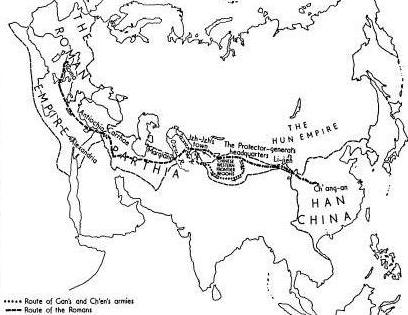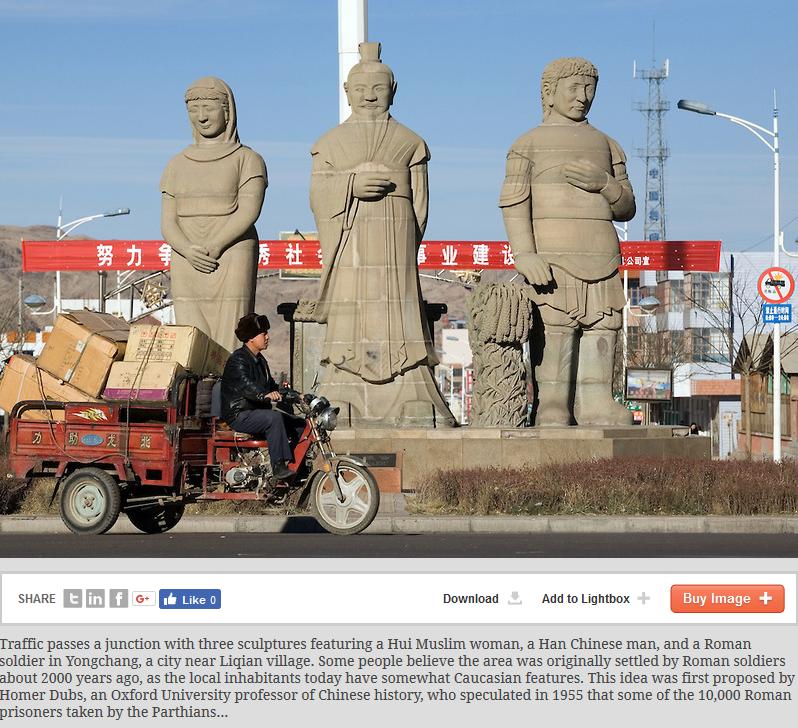Homer Hasenpflug Dubs and Roman Legionaries in Ancient China December 20, 2010
Author: Beach Combing | in : Ancient , trackbackDrum roll, trumpet blast enter Homer Hasenpflug Dubs (obit 1969) an American-born Oxford don with a name that sounds as it it was purloined from an 1890s feel-good novel. Homer, to friends, was a capable if eccentric sinologist based out of ‘the other place’ for most of his teaching life. He wrote – as was typical of that pioneering generation of western sinologists – on everything from the date of Confucius’s birth to Chinese alchemy. However, he would probably have gone unnoticed among bizarrists if it was not for a work published in 1957, ‘A Roman City in Ancient China’.
This title is – as Homer was fully aware – a racy little slap in the face to orthodoxy. To the best of scholars’ knowledge direct contact between the Romans and the Chinese was either non-existent or so infrequent as to be irrelevant – four thousand miles are a lot of steppe to cross. In fact, Beachcombing has enjoyed looking at the claims for Roman contacts with central and easterm Asia in the past and found them largely wanting: (1), (2).
So what was Homer up to?
Beachcombing will try and set out the concatenations of his argument in point form.
(i) A Chinese source dating to 5 AD states that there is city in Western China with the name, Li-jien, meaning ‘Rome’.
(ii) In 54 BC many thousands of Roman soldiers had been captured by the Persians and moved to the east of the Persian Empire in Margiana. There were numerous Romans then in the right place at the right time.
(iii) In 36 BC a Chinese campaign in nearby Sogdiana seems to describe Roman soldiers fighting with the Hun armies against the Chinese, 145 of whom were captured by these Chinese and likely moved into China.
Beachcombing is rubbing his hands before the fire of Homer’s circumstantial kindling here and is still frozen to the marrow.
So (i) is interesting but may relate to a settlement with trading links with the Mediterranean (particularly given its position), not necessarily a settlement of Roman soldiers.
(ii) Is unquestionably correct – Beachcombing examined the claim on another occasion – but Margiana and Sogdiana are separated by a thousand miles of the most daunting territories in the world: mountain, deserts…
Dubs’ joy though was (iii) and here it is worth quoting directly from his source, Ban Gu (92 AD) who is describing pictures recalling the battle between the Han Chinese and the Huns in Sogdiana. As the reader passes through this description he would do well to ask him or herself where Dubs’ evidence is for a Roman presence. Beachcombing is keeping mum for the moment, leaving the clues hidden by way of a challenge. Remember the Romans are fighting against the Chinese!
The first scene was of the Chinese camp, with the Shan-yü’s capital town [base of the Hun army] at a distance of about a mile. On the wall of the latter are mounted coloured banners, with armed men shouting, ‘Come and fight!’ Outside the wall horsemen gallop about, and more than a hundred foot-soldiers are lined up on either side of a gate in a fish-scale formation.
In the second scene the Hun cavalry is galloping up to the Chinese camp, where the Chinese await them with cocked and loaded crossbows, before which the Hun cavalry retreat.
In the third scene the Chinese army, urged on by its battle drums, is surrounding the city on all sides, sheltering behind its large shields, and shooting at the cavalry and foot outside the city, who are retreating behind the city wall. Some are shooting at the defenders in the towers inside the town, and the defenders come down for shelter. But from a double wooden palisade outside the town the defenders shoot and kill many of the attackers, and so the Chinese set fire to this palisade.
In the fourth scene the Shan-yü has donned his armour, ascended a tower with his consort and several tens of his ladies. All are shooting at the Chinese. But the attackers have hit the Shan-yü in the nose. Many of the women are killed. The Shan- yü is also shown having descended from the tower, mounted on a horse, and summoning those inside his palace to fight.
In scene five it is after midnight. The palisade has burned down and the remaining defenders are fleeing into the city. Some have mounted the wall and are shouting loudly. Outside the city and around the Chinese camp there are large groups of Sogdian cavalry [Hun allies]. Some are charging up to the Chinese and being repulsed. In the sixth scene it is dawn. On all sides of the camp fire is bursting forth. The Chinese officers and men are shouting wildly and the noise of their bells and drums is shaking the earth. The Sogdian cavalry, frightened, is fleeing.
In the seventh scene the Chinese and allied troops are advancing upon the city under the cover of their large shields on all sides. Some have already entered. The Shan-yü, with more than a hundred men and women, is flying into his wooden palace.
In the eighth and final scene the Chinese have set fire to the palace and are vying with one another in their efforts to enter it. Some have entered, and, in a hand-to-hand fight, have mortally stabbed the Shan-yü. His head is cut off by a Chinese captain.
Well, according to Dubs there were two proofs of a Roman presence here.
Ready for it?
The reference to ‘fish-scale’ formation that Dubs took as a reference to the testudo of the Romans; and the wooden palisade built before the wall, as it transpires that only Romans built wooden palisades…
Dubs’ arguments are certainly not unimpeachable.
So ‘[t]his term, a ‘fish-scale formation’, yü-lin-jen, is unique in all Chinese literature. A high degree of training and discipline would have been required to achieve an array so well patterned that it would be likened to fish-scales. Certainly no nomadic people, such as the Huns or any uncivilized peoples, could have achieved it. Nomads and barbarians, like the Gauls, rushed to battle in a confused mass. A well-patterned array can be achieved only by long-trained men, such as professional soldiers.’
If the ancient Huns were not professional soldiers Beachcombing does not know who qualifies…
Then as to the palisades: ‘[t]he presence of Romans at Jzh-jzh’s town is confirmed by the double wooden palisade which the Chinese found outside the city wall. The Greeks used no palisades outside city walls, but the Romans regularly used them to strengthen their ditches, especially before gates. Where there was a bridge over water, there might be stockades built out from either bank above or below the bridge. So Jzh-jzh evidently had Roman engineering assistance in building his defences.’
So only the Romans had the technical know how to erect some wooden timbers before a city wall!
And yet many favourable pages have been written on the Roman settlement of western China on the basis of Dubs’ weak arguments here. Nor have these weak arguments stopped the opportunistic modern Chinese tourist industry identifying their Roman city as Lou Zhuangzi with some nonsense about Caucasian populations with blue eyes – Roman soldiers being well known for their Aryan faces… Caucasian populations are, of course, common in this part of the world and are probably to be associated with early Indo-European offshoots rather than 145 Roman legionaries.
Nevertheless,
‘County officials, sensing potential tourist revenue, have erected a Doric pavilion in Lou Zhuangzi, while the county capital of Yongchang has decorated its main thoroughfare with enormous statues of a Roman soldier and a Roman woman flanking a Communist party official.’
The disneyfication of pseudo-history!
Beachcombing would though kill to see photos if anyone has a copy: drbeachcombing AT yahoo DOT com
Beachcombing also hopes to review here in the near future a fine and atmospheric book, the best thing to come out of the search for Li-jien: Black Horse Odyssey by David Harris.
***
31 Dec 2010 On the subject of Roman legion’s in China Wilson writes in with an interesting link, putting the Caucasian claims in perspective. Thanks Wilson!
EC, 29 Apr 2018 with some Roman statues in China!!!!! Screen shotted just in case it disappears.




